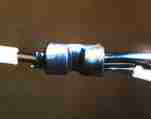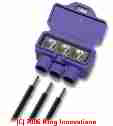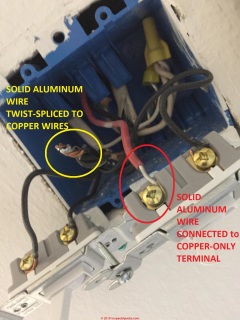 Aluminum Wiring Hazard & Repair Procedures
Aluminum Wiring Hazard & Repair Procedures
Home Page & Article Index
- POST a QUESTION or COMMENT about aluminum electrical wiring: hazards, risks, proper repairs, identifying aluminum wiring. Questions and Answers about Aluminum Wiring Hazards, Failures, Failure Cause, & Aluminum Wiring Repairs
We answer just about any question concerning aluminum electrical wiring, aluminum wiring failure causes, cures, repairs, and prevention.
We include authoritative, expert aluminum wiring failure research, field failure reports, and descriptions of approved aluminum wiring repair procedures and products.
At page top, an illustration from a research report by Dr. Jess Aronstein illustrates how aluminum wire electrical connections overheat to start a fire. At the point shown in Aronstein's photograph, the twist-on connector is completely burned but the electrical fire continues, having ignited the plastic jacket of the wire insulation and the cable jacket end.
In the wall of an actual building, this fire may spread outside of the electrical box, or it may not, depending on the actual environment and what combustible materials are close to the electrical box. Aronstein concludes that in any event, the inside of an electrical box in a building is no place for burning materials.
InspectAPedia tolerates no conflicts of interest. We have no relationship with advertisers, products, or services discussed at this website.
- Daniel Friedman, Publisher/Editor/Author - See WHO ARE WE?
Aluminum Electrical Wiring Dangers, History, & Repair Procedures

This website describes the hazards and remedies for aluminum electrical wiring - a fire hazard in homes. We provide complete and authoritative research, technical information, description and explanation of why solid conductor branch circuit wiring of aluminum is unsafe, and we describe both proper and improper repair methods for aluminum electrical wiring.
Watch out: unless it has been repaired properly, solid-conductor aluminum electrical wiring, installed in homes in North America in the 1960's and 70's is a fire hazard in buildings. Aluminum electrical wire was never "recalled" in the U.S. nor in Canada. The absence of a product recall is not an assurance that it is safe.
Aluminum electrical wiring is indeed "safe" in buildings if it has been properly repaired using methods and connectors described at this website.
[Click to enlarge any image]
Just how safe is un-repaired aluminum wiring? According to the U.S. Consumer Product Safety Commission, fires and even deaths have been reported to have been caused by this hazard.
Mis-information about aluminum wiring is widespread and its failure mechanism leading to overheating is usually not explained properly.
Problems
due to aluminum wiring expansion, or much more likely micro-fretting and arcing at the aluminum wiring connectors,
can cause overheating at the connections between the wire and
devices (switches and outlets) or at aluminum wire splices.
The connections can become hot enough
to start a fire without ever tripping a circuit breaker!
The photos shown at left and just below are not the most dramatic catastrophes linked to fires caused by aluminum wiring. But these are conditions that are found in many homes with aluminum wiring, confirming that this is a real, common, and widespread hazard.
CPSC research shows that "homes wired with aluminum wire manufactured before 1972 are 55 times more likely to have one or more connections reach "Fire Hazard Conditions" than are homes wired with copper.
"Post 1972" aluminum wire is also a concern. Introduction of the aluminum wire "alloys" in 1972 time frame did not solve most of the connection failure problems.
Aluminum wiring is still permitted and used for certain applications, including residential service entrance wiring and single-purpose higher amperage circuits such as 240V air conditioning or electric range circuits.
The fire risk from single purpose circuits is much less than for branch circuits.
But it's not necessarily because of a "new alloy" as some folks assert. It's because there are enormously fewer connections (four or six rather than 30 or 40 per circuit) and thus statistically a smaller chance of a connection failure. These connections do still burn up, as indicated by field reports.
List of Key Articles on Aluminum Wiring Hazards & Repair Methods
Photos below show an improper aluminum-to-copper pigtail splice which is overheating, and an infra-red photo of the same connection, from a more distant view (courtesy of G. Cohen). Aluminum wire connections can overheat enough to start a fire without ever drawing enough current to trip a circuit breaker.
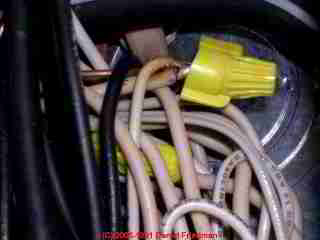
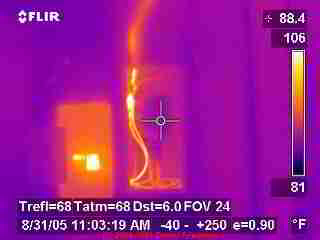
- ALUMINUM WIRING HAZARDS & REPAIRS The Aluminum Wiring Website - home page, describing the hazards of & repairs for aluminum electrical wiring, including authoritative, in-depth information, photographs, documents. You are on the aluminum wiring website main page.
- HOW TO RECOGNIZE or IDENTIFY ALUMINUM ELECTRICAL WIRING in buildings
- HOW TO REDUCE THE RISK (how to repair aluminum wiring) in buildings with Aluminum Electrical Wiring - Overview of Acceptable Repair Practices (in the document you are presently viewing)
- COPALUM Electricians: Sources of TYCO COPALUM -Certified/Trained Aluminum Wire Repair Services (in the document you are presently viewing)
- COPALUM ALUMINUM WIRING CONNECTOR AVAILABILITY: How to Get the Proper Aluminum Wire Connectors - U.S. CPSC announced that Tyco Electronics Corp. will continue offering the COPALUM connector repair system until at least 2005 - for details see
the US CSPC-Tyco Press Release. - ALUMINUM WIRE AlumiConn - terminal block type connector recommended by the US CPSC for aluminum wiring repair, an alternative approach to the COPALUM device: where to buy & how to install the AlumiConn connector for aluminum wiring repairs
- OTHER PRODUCTS, Ideal 65 Purple Twister (not recommended), & other Aluminum Wire Products/Articles (in the document you are presently viewing)
- ALUMINUM WIRING BIBLIOGRAPHY: extensive resources on Aluminum Wiring
- ALUMINUM WIRING FAILURE REPORTS & Photos Real life aluminum wiring field failure reports
- HOW TO IDENTIFY ALUMINUM WIRING, recognition photos of wire insulation, exterior and interior appearance, use in situ in electrical panels, junction boxes, and other clues indicating the presence of aluminum electrical wiring in buildings
- 05/21/2007 REDUCING the FIRE HAZARDS in ALUMINUM-WIRED HOMES - 2007 [PDF document], Jess Aronstein, Ph.D., 21 May 2007. This document answers most technical questions about the hazards and remedies of aluminum electrical wiring and includes a report on independent test results of alternative products and methods for repairing aluminum wiring. Some of the sections of this very thorough document are listed below:
- 02/09/2006 REDUCING the FIRE HAZARDS in ALUMINUM-WIRED HOMES - 2006 [Web Page], Jess Aronstein, Ph.D., This older version of the above document also answers most technical questions about the hazards and remedies of aluminum electrical wiring but lacks latest repair product testing such as the AlumiConn connector discussed above. Some of the sections of this very thorough document are listed below:
- Aluminum Electrical Wiring Information for your website: for information on aluminum electrical wiring that can be copied to your website,
see ALUMINUM WIRING SUMMARY PAGE for Public Use. - you can copy this page in any form as long as it's use is not to sell a product or service - THERMOGRAPHY IR Infra Red & Thermal Scanners - discusses use of infrared and thermography images and temperature scanning equipment
The AMP TYCO COPALUM Connector for Aluminum Wiring Pigtailing Repairs
AMP TYCO COPALUM Copper-to-Aluminum Pigtailing Use the special AMP (now TYCO) COPALUM high pressure crimp connector and special tool to connect short copper wires to every aluminum wire end in the building, reconnecting the copper to the various devices (outlets, switches, lights) and splices.
The AMP (originally TYCO) COPALUM connector method is described
is described in detail
at PIGTAILING USING AMP "COPALUM" CONNECTORS.
COPALUM ALUMINUM WIRING CONNECTOR AVAILABILITY discusses how to get these aluminum wire connectors
The AlumiConn™ Aluminum Wiring Connector for Pigtailing and Repairs
AlumiConn TM Purple #95135 aluminum to copper lug connectors [New in 2006, U.L. Listed, 2007 completed independent testing] available from King Innovation.
The AlumiConn connector is now recommended for aluminum wiring repairs - US CPSC.
Results of independent testing indicate that this product "... is predicted to have a high probability of failure-free long-term safe performance, PROVIDED THAT THE SETSCREWS ARE CAREFULLY TIGHTENED TO THE MANUFACTURER'S RECOMMENDATION".
Alumi-Conn where to buy, how to install:
- ALUMINUM WIRE AlumiConn™ describes using this device and how it is connected, wired, and torqued.
- ALUMINUM WIRE REPAIR SPLICE SPACE describes steps to gain sorely-needed wiring space when using the AlumiConn™ (or the harder to obtain COPALUM™) connector for the copper pigtail repair method for aluminum wiring, and this article also includes photographs of the steps in a reader's actual field installation experience using the AlumiConn splice connector.
- The actual AlumiConn WEBSITE is http://www.kinginnovation.com/products/alumiconn/ This site has installation videos, Wire combinations, specification sheets, and other information and assistance in using this product.
- The AlCopSTORE is an independent website where you can also purchase the AlumiConn™ aluminum wiring connector.
Obsolete Aluminum Wiring Repair Method - No Longer Recommended
Scotchlok 3M Special Method [- superceded by new alternate repair as of June 2007 -]: this ""Scotchlok 3M Special Method was previously recommended as independent tests showed that it performed acceptably.
While this repair method has been superceded by new alternate repair as of June 2007, we have kept this description available to aid home buyers, electricians and home inspectors who may discover or need to be able to recognize this aluminum wire repair method if it was previously used in the building.
A summary of this method is at Scotchlok 3M CONNECTOR and
details of this method are at SCOTCHLOK 3M REPAIR CONNECTORS repair method.
Other Aluminum Wiring Repair Methods that Are Not Recommended
Other methods - not recommended: Warnings regarding other "repair" methods which are not recommended are discussed
at ALUMINUM WIRING REPAIR, Other Products,
such as the Ideal 65 purple "Twister" connector shown in the photo at left (12 connectors cost $49. to $79.), Marrette B-Cap ACS™ #63 AL/CU Twist-On Connectors, and electrical receptacles and outlets marked "COALR" (even if these worked, which has not been demonstrated, what about all of the other electrical connections and splices in the building?) and others.
Citation by brief quote or links-to this website are invited, provided you credit this
source website ALUMINUM WIRING HAZARDS & REPAIRS InspectAPedia.com/aluminum/Aluminum_Wiring_Hazards.php
Printed copies of our website pages are permitted (hard copies on paper) for free (not for sale) distribution provided that you do not edit the content, you include a citation of the source web page, and you do not imply that our website is endorsing any product or service for sale.
Do NOT copy electronically nor reproduce our website content electronically (for example to a web page) without writing to us (CONTACT US) first to obtain express permission. See our InspectApedia.com CONTENT USE POLICY - it's OK in printed form only, do not make electronic copies.
Aluminum Electrical Wiring Information you CAN copy to your website: for information on aluminum electrical wiring that can be copied to your website,
see Aluminum Wiring Summary Page for Public Use.
11/17/2019 Aluminum Wiring Home Page, InspectAPedia.com/aluminum/Aluminum_Wiring_Hazards.php - © 2017 - 1988 Copyright InspectAPedia.com All Rights Reserved,
The information on this page may not be reproduced or republished on another web page or website - InspectAPedia® is a Registered U.S. Trademark
InspectAPedia is an independent publisher of building, environmental, and forensic inspection, diagnosis, and repair information provided free to the public - we have no business nor financial connection with any manufacturer or service provider discussed at our website. We do not sell products nor services.
We are dedicated to making our information as accurate, complete, useful, and unbiased as possible: we very much welcome critique, questions, or content suggestions for our web articles. Working together and exchanging information makes us better informed than any individual can be working alone.
...
Reader Comments, Questions & Answers About The Article Above
Below you will find questions and answers previously posted on this page at its page bottom reader comment box.
Reader Q&A - also see RECOMMENDED ARTICLES & FAQs
On 2022-11-07 by Bob D. - replace all aluminum wiring after storm damage & flooding
My home was built in early 1970s and has aluminum wiring. Our home was damaged in a hurricane which ripped the roof decking off the rear of our home. Due to the amount of water and wind that entered our home our electrician has recommended we remove all aluminum wiring.
I’m not sure who to turn too so I know everything is being replaced correctly. Thanks
On 2022-11-07 by InspectApedia (Editor) - how do I repair damaged wiring from hurricane
@Bob D.,
I think there are probably several issues here. Naturally I can't assess by text whether you're wiring itself was actually water damaged but I'm sure you've read by now that aluminum wiring is a fire hazard. The hazard occurs at the connections.There is an approved repair method using one of two specific connectors to install copper pigtails at each connection. So unless there's some evidence that the wiring itself is damaged and unsafe the connection repair approach should be considerably less costly.
Ask for specifics about what sort of damage was seen and let me know. It would be helpful to see some photos of conditions, one per comment and as many comments and photos as you like.
I think part of the problem is that the electrician may be nervous about working on your wiring because of a concern for liability.
On 2022-11-07 by Bob D. - structural engineer gives bad news to replace all trusses
@InspectApedia (Editor), Hi. Thanks so much for the information. Today i finally had a structural engineer come out and give me the bad news that he recommends that all of the trusses in the house be replaced. So it seems like everything will be demo'ed and replaced. Thanks again for your help.
On 2022-11-07 by InspectApedia (Editor)
@Bob D.,
By separate private email you wrote:
My home was severely damaged from Hurricane IAN. The roof decking was torn off across the whole back of my home. Which caused the ceiling to come down in 4 rooms. There was also water on all floors in all rooms.
Our home has aluminum wiring and our electrician has recommended to remove it all and replace with copper not just because of damaged wiring but water damage to aluminum. The electrician and general contractor both said I should get an inspection for structural issues. Are there engineers that can inspect all components of your home, or should I get folks who are specialized in a particular area. Thanks in advance for any help.
We replied:
Structural questions can be addressed by an engineer who is trained in structural or civil engineering. Most Engineers are not expert in the details of building electrical and mechanical and other subsystems.
An experienced home inspector who is willing to examine storm damage to buildings may not be qualified to assess structural damage but should be capable of giving you a general idea of the scope of work that's necessary on your building across all of its systems.
Be sure to read
FLOOD REPAIR PRIORITY STEPS
ELECTRICAL SAFETY for FLOOD DAMAGE INSPECTORS
FLOOD REPAIR CONTRACTORS
About your electrical wiring, independent of the alumnum,
In any home, electrical wiring that has been under water is unsafe until it has been inspected and perhaps had several types of components replaced. For example even if plastic-covered wiring itself appears un-damaged, electrical connections, splices, junction boxes, electrical receptacles, light switches have been wet and are at risk of corrosion.
On 2022-04-03 by Robert Ketcheson - use antioxidant paste and a twist on connector for aluminum wire repair?
What about coating the aluminum wires & copper wires with anti-ox agent before twisting together under a traditional Marette?
I had heard from an electrician that this will prevent oxidization on the wires and will neutralize any heat discrepancy between the two conductors. Is this not correct?
On 2022-04-03 by InspectApedia (Editor) - don't use twist on connectors with antioxidant for an aluminum wiring pigtailing repair
@Robert Ketcheson,
Thank you for the question about using a particular brand of twist on connectors with antioxidant for an aluminum wiring pigtailing repair.
You will find that option described in detail in this article series.
And you will read that simply cutting the wires and using antioxidant combined with a twist on connector is not safe and leads to overheating and fires.
Even simply looking at the photographs on this page you will see that part of the problem is that the current is flowing through the spring of the connector rather than from wire-to-wire. As a result the device overheats, melts, and invites building fire.
There was a procedure that involved a much more complicated process in which the wires were stripped, coated with antioxidant, and then abraded or sanded through the antioxidant, however the researcher that who did that work finds that the current approved connectors for aluminum wiring are safer and much less complex and will perform better.
Watch out: Bottom line don't do what you suggested. Using twist on connectors for aluminum wiring repair is unsafe, is not recommended by the US CPSC, and may also cause you to lose your fire insurance coverage.
Use one of the two approved aluminum to copper pigtail and connectors.
On 2021-02-24 by Travis - Why can't 2-2-2-4 SER aluminum wire be run in conduit, unerground?
Why can't 2-2-2-4 SER aluminum wire be run in conduit, unerground?
On 2021-02-24 by danjoefriedman (mod)
@Travis, this sounds like one of those unanswerable questions like "are you still beating your wife?"
Your question contains a false premise.
There are in fact aluminum service entrance cables that are rated for underground use. For example
2-2-2-4 Dyke Quadruplex Aluminum Conductor Underground Direct Burial 600V URD
On 2020-12-18 by John - Is copper clad aluminum safe?
Is copper clad aluminum safe
On 2020-12-18 by danjoefriedman (mod) - copper clad aluminum safety
John
thank you for helpful question about the safety of copper clad aluminum wiring.
YES - All of the sources that we have reviewed and experts whom we've consulted agree the copper clad aluminum wiring performs about as well as copper wiring. It doesn't have the same connection, arcing, corrosion, overheating issues as those aluminum wire.
Obviously I can't say a thing about the safety of your particular wiring installation because safety depends on so many other installation details. But the wire itself has been found to perform correctly and safely.
On 2019-12-27 by Deborah Haney - safe to use new high wattage appliance on an aluminum-wired circuit?
I have been given a new cooking appliance that is rated power of 1200 watts. It is a compact oil-less fryer, that I am wondering if it is safe to use in an aluminum wired mobile home. Does anyone have a qualified answer?
On 2019-12-27 by danjoefriedman (mod) - NO electrical device is safe in an aluminum wired home
Deborah
Thanks for asking an important aluminum wire safety question.
Frankly, NO electrical device and NO connections in an aluminum wired home are "safe" and there is a serious fire risk unless the wiring has been properly repaired using one of the two methods recommended by the US CPSC: the AMP COPALUM crimp connector pigtailing copper to the original aluminum at every single connection throughout the home, or the AlumiConn connector similarly installed.
And yes, using a higher wattage appliance may increase the risk of overheating and a fire.
I'm not sure what constitutes a "qualified answer" to you but throughout this article series you'll read explanations by experts in and out of government and in the References section of each article you'll find more authoritative sources on which these articles are based.
On 2019-11-16 by Colby Roper - are "aluminum only" or COLAR devices safe?
Is it even worth changing the devices out to "aluminum only" devices in an aluminum wired home? Customer is trying to save money, although I know that this is probably not even a good idea! She still wants some kind of pricing on the different repair methods.
On 2019-11-17 by danjoefriedman (mod) - "aluminum only" devices have high failure rate
Sorry but NO. Those devices have an equally high failure rate.
Question: examples of improper aluminum wire connections to switches & aluminum-copper twisted splice
2019/12/15 Theo said:
I need to ask about aluminum and copper codes I’ll show some pictures below thank you for any information
Legal?
This Q&A were posted originally
at ELECTRICAL INSPECTION, DIAGNOSIS, REPAIR
Moderator Reply:
Theo
What is "legal" is in the hands of your local electrical inspector.
However I can see that there is a device marked USE SOLID COPPER or CU CLAD ALUMINUM ONLY.
Yet that device in your photos has solid conductor aluminum wires connected to one of its terminals.
Correctly speaking that violates the manufacturer's device specifications and instructions and therefore should be considered a violation of the National Electrical Code (if you are in the U.S.).
I also see that there is a twisted wire splice mixing copper and aluminum. That connection is unsafe and improper as well.
The ONLY copper-to-aluminum connections recommended by the US CPSC are using the AMP COPALUM or the AlumiConn connector block.
See details at ALUMINUM WIRING REPAIR METHODS
Click to open the ARTICLE INDEX given above to see all or our aluminum wiring articles.
...
Continue reading at ALUMINUM WIRING IDENTIFICATION or select a topic from the closely-related articles below, or see the complete ARTICLE INDEX.
Or see ALUMINUM WIRING HAZARD FAQs - questions & answers posted to this article
Or see these
Recommended Articles
- ALUMINUM WIRING HAZARDS & REPAIRS - home
- ALUMINUM WIRING BIBLIOGRAPHY
- ALUMINUM WIRE FAILURE REPORTS
- ALUMINUM WIRE GROUNDS
- ALUMINUM WIRING IDENTIFICATION
- ALUMINUM WIRING RENTAL HOME ADVICE
- ALUMINUM WIRING REPAIR METHODS
- ALUMINUM WIRING REPAIR ELECTRICIANS
- ALUMINUM WIRING REPAIRS NOT-RECOMMENDED
- ALUMINUM WIRING SAFETY ASSESSMENT - CPSC
- ALUMINUM WIRING GUIDE for HOME INSPECTORS
- ALUMINUM WIRIING SUMMARY free to copy page
- COPPER-CLAD ALUMINUM WIRE
- DMM DIGITAL MULTIMETER HOW TO USE
- ELECTRIC PANEL INSPECTION
- REDUCE THE AL WIRE RISK: DETAILS
Suggested citation for this web page
ALUMINUM WIRING HAZARDS & REPAIRS at InspectApedia.com - online encyclopedia of building & environmental inspection, testing, diagnosis, repair, & problem prevention advice.
Or see this
INDEX to RELATED ARTICLES: ARTICLE INDEX to ELECTRICAL INSPECTION & TESTING
Or use the SEARCH BOX found below to Ask a Question or Search InspectApedia
Ask a Question or Search InspectApedia
Try the search box just below, or if you prefer, post a question or comment in the Comments box below and we will respond promptly.
Search the InspectApedia website
Note: appearance of your Comment below may be delayed: if your comment contains an image, photograph, web link, or text that looks to the software as if it might be a web link, your posting will appear after it has been approved by a moderator. Apologies for the delay.
Only one image can be added per comment but you can post as many comments, and therefore images, as you like.
You will not receive a notification when a response to your question has been posted.
Please bookmark this page to make it easy for you to check back for our response.
IF above you see "Comment Form is loading comments..." then COMMENT BOX - countable.ca / bawkbox.com IS NOT WORKING.
In any case you are welcome to send an email directly to us at InspectApedia.com at editor@inspectApedia.com
We'll reply to you directly. Please help us help you by noting, in your email, the URL of the InspectApedia page where you wanted to comment.
Citations & References
In addition to any citations in the article above, a full list is available on request.
- Aluminum Electrical Wiring Information for your website: for information on aluminum electrical wiring that can be copied to your website, see Aluminum Wiring Summary Page for Public Use.
- "Repairing Aluminum Wiring", US CPSC Publication 516, U.S. Consumer Product Safety Commission, Bethe3sda MD, website: www.cpsc.gov / www.SaferProducts.gov, updated June 2011, original source: .cpsc.gov/cpscpub/pubs/516.pdf, Quoting:
The U.S. Consumer Product Safety Commission (CPSC) staff and other government officials have investigated numerous hazardous incidents and fires throughout the nation involving aluminum branch circuit wiring. A national survey conducted by Franklin Research Institute for CPSC showed that homes built before 1972, and wired with aluminum, are 55 times more likely to have one or more wire connections at outlets reach “Fire Hazard Conditions”1 than homes wired with copper. That survey encompassed only the wire connections at outlets. It did not address other types of aluminum wire connections and splices in homes that are also prone to fail. No information was developed for aluminum-wired homes built after 1972.
The fire hazard investigated by CPSC occurs at connections with aluminum wire, including receptacles or switches and junction boxes; or the hazards occur with major appliances, including dishwashers or furnaces, for example. There are several deterioration processes in aluminum wire connections that cause increased resistance to the flow of electric current, resulting in damage that is cumulative in effect. That increased resistance causes overheating, sometimes at hazardous levels, when current is flowing in the circuit. - AlumiConn website - www.kinginnovation.com/products/alumiconn/ has installation videos, Wire combinations, specification sheets, and other information and assistance in purchasing or using this product.
- AlumiConn™ AlCopStore.com
223 Salt Lick Road, #279,
St. Peters, MO 63376
Tel: 866-826-2256, Fax: 636-754-0500, Email Sales: pking@AlCopStore.com, Email General Inquiry: info@AlCopStore.com - "Repairing Aluminum Wiring," [As updated 2011] U.S. Consumer Product Safety Commission Publication available online
- "Repairing Aluminum Wiring," [Original, now obsolete] U.S. Consumer Product Safety Commission Publication REPAIRING ALUMINUM WIRING, US CPSC Pub. No. 516available online
- "Record of Commission Action, Commissioners Voting by Ballot", CPSC Publication No. 516, Repairing Aluminum Wiring (original version op.cit.), (Briefing package dated March 15, 2011), Quoting:
The Commission voted unanimously (5-0)·to approve republication of CPSC Publication No. 516, Repairing Aluminum Wiring, with the explicit recognition that the COPALUM and AlumiConn connectors currently are the only products that meet the agency's standards to prevent aluminum wire fire hazards
Copy on file as /aluminum/Pub516_Alumi_Conn.pdf
- Southwire Corporation, manufacturer of aluminum (and other) wire products
- What Owners Need to Know About [Aluminum] Wiring Dangers, Sandra Fleishman, Washington Post, 3 July 2004 pF01

Carson Dunlop's Home Inspector's Home Study Course (DJF is a contributor and participant in this education project).
- Dr. Jess Aronstein, protune@aol.com is a research consultant and an electrical engineer in Schenectady, NY. Dr. Aronstein provides forensic engineering services and independent laboratory testing for various agencies. Dr. Aronstein has published widely on and has designed and conducted tests on aluminum wiring failures, Federal Pacific Stab-Lok electrical equipment, and numerous electrical products and hazards. See ALUMINUM WIRING BIBLIOGRAPHY and see FPE HAZARD ARTICLES, STUDIES for examples.
- "The Influence of Corrosion Inhibitor and Surface Abrasion on the Failure of Aluminum-Wired Twist-on Connections", Aronstein, J.; Campbell, W., Components, Hybrids, and Manufacturing Technology, IEEE Transactions on Volume 7, Issue 1, Mar 1984 Page(s): 20 - 24
- "Overheating Failures of Aluminum-Wired Special Service Connectors", J. Aronstein and W.E. Campbell,
IEEE Transactions, Vol. CHMT-6, No. 1, March 1983.
This paper appears in: Components, Hybrids, and Manufacturing Technology, IEEE Transactions on Publication Date: Mar 1983 Volume: 6, Issue: 1 On page(s): 8 - 15 ISSN: 0148-6411 Current Version Published: 2003-01-06. This paper is available to IEEE members and subscribers and can be obtained through public or academic libraries.
Abstract: Special service" twist-on connectors are tested with aluminum and copper wire combinations. The special service connectors are qualified by a Canadian standard which applies to connectors for use with aluminum branch circuit conductors. Two brands of special service connectors are presently qualified by this standard and marketed. Both are rated for various combinations of aluminum and copper conductors. Samples of both brands are tested in this investigation. The tests are conducted within rated electrical and environmental conditions, with connections made according to the connector manufacturers' instructions. Overheating failures have occurred among the aluminum-wired special service connector combinations. The failures are accelerated by humid environment to a greater extent than by the application of electrical current. In contrast, connections which are copper-wired, using either standard or special service connectors, are stable and failure-free. The difference between the standard twist-on connectors and the special service connectors is in the material used for the connector spring. Improved compatibility between the spring material and the aluminum conductor, compared to the plated steel springs of the conventional twist on connectors, has not dealt with several important failure mechanisms. The test results indicate that the new standard, as presently defined, cannot be relied on to screen out aluminum-wired connector combinations which will not survive long-term operation within rated conditions. Thus the objective of accelerated qualification testing-- the prediction and assurance of safe and reliable operation in actual service---is not achieved in this case. The reasons are discussed, along with possible improvements. - "Evaluation of a Twist-on Connector for Aluminum Wire", Dr. Jesse Aronstein, Forty-Third IEEE Holm Conference on Electrical Contacts, Jan 1997, 0-7803-3968-1/97.
[This article describes the Ideal Industries Ideal#65 purple "Twister" twist-on connector marketed as a repair/retrofit for residential aluminum wiring. --DJF]
Abstract: A new type of twist-on splicing component for use with aluminum and copper wire combinations is tested to determine initial resistance, performance in a zero-current environment test, performance in a heat-cycle test, and portion of current carried by the connector's steel spring. The splices tested consist of two aluminum wires and one copper wire.
The aluminum wire samples used for the test are of the types actually installed in aluminum-wired homes. Initial resistance is found to be relatively high, and there is a significant sample-to-sample variation. This reflects failure to consistently establish low-resistance wire-to-wire contact through the insulating oxide film on the wire. Results of the environmental and heat-cycle tests show deterioration of a significant portion of the samples.
The splices made with this connector are also found to be sensitive to mechanical disturbance, such as applied in normal installation when the completed splice is pushed back in to the junction box. Based on the test results, it is concluded that this connector has not overcome the fundamental deficiency of twist-on connectors for use with aluminum wire applications. Keywords: aluminum wire, connectors, twist-on connectors, environmental test, heat-cycle test. - Harbor Freight Hydraulic Wire Crimping Tool Model 66150 instruction manual
- Marrette® (Brown)Company, (Canadian Thomas & Betts) ACS™ Aluminum Wiring connector product brochure indicates that this connector is "approved for circuits up to 600V and lighting fixtures and signs up to 1000V, not UL Listed (therefore not approved for use in the United States).
- Thomas & Betts, 8155 T&B Boulevard Memphis, TN 38125 USA, is a producer of more than 30,000 electrical components. 888-862-3289. Quoting the company:
Thomas & Betts offers more than 30,000 high-quality products marketed under a variety of market-leading brand names. Designed to help passively conduct electricity, Thomas & Betts products are found everywhere electricity is used -- inside commercial and industrial buildings, in homes and schools, inside complex machinery and original equipment, in the power generating plant and distribution network, outside your home and underground. - FAQs on author/website credibility
- Website Kudos
- 12/1995 - PC Computing Magazine: Names this website as among the "Best 1001 Internet Sites." See the Engineering category, p. 146.
- Starting Point: named this website as a key Internet resource page as a Starting Point Hot Site
- In addition to citations & references found in this article, see the research citations given at the end of the related articles found at our suggested
CONTINUE READING or RECOMMENDED ARTICLES.
- Carson, Dunlop & Associates Ltd., 120 Carlton Street Suite 407, Toronto ON M5A 4K2. Tel: (416) 964-9415 1-800-268-7070 Email: info@carsondunlop.com. Alan Carson is a past president of ASHI, the American Society of Home Inspectors.
Thanks to Alan Carson and Bob Dunlop, for permission for InspectAPedia to use text excerpts from The HOME REFERENCE BOOK - the Encyclopedia of Homes and to use illustrations from The ILLUSTRATED HOME .
Carson Dunlop Associates provides extensive home inspection education and report writing material. In gratitude we provide links to tsome Carson Dunlop Associates products and services.



